Blog Archives
10,000 Easy Steps to Entrepreneurial Success
The key to entrepreneurial success lies at your doorstep
I have to admit, I was hesitant to share below thoughts with you as they do not relate to your branding pain points, nor are they utilizing my core expertise. Yet it presents advice dear to my heart.
We read a lot about the steps it takes to be a successful entrepreneur. They revolve around networking, innovation, perseverance, collaboration, seizing opportunities, and on and on goes the list. A list of advice you and I both often get trapped in – or so I assume – since we are heading towards the same goal of being a great entrepreneur, regardless if you are just starting out/up, or if you have been successfully in business for decades.
I suggest 10,000 steps to success.
Daily. That’s right, 10,000 steps daily, and I mean that literally.
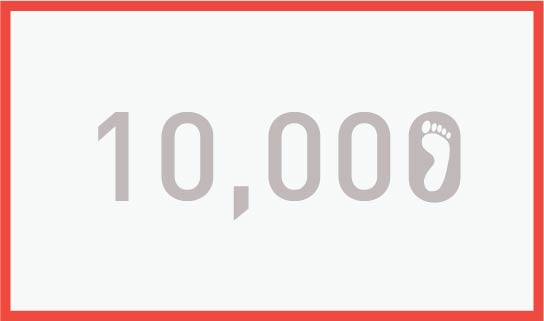
Successful entrepreneurs walk. A lot. And not on a treadmill. They walk, because it is their secret weapon for mind and body to be in balance, resulting in a productivity and creativity boost. This is a good thing for every body, but essential for entrepreneurs.
When you start walking, two amazing things happen:
- You are by yourself. You are not in front of a screen nor conversing with others. This leads to your mind having some free time to wander off.
- You are re-invigorating your body. Mens sana in corpore sano – A sound mind in a sound body. Age old wisdom, we all know it, but we focus on extreme workouts or busy gyms instead of long, meditative walks.
As many of you know, I spend my days conducting brand strategy sessions with my clients, sometimes 9 hours in one go, until we find the right strategy. I speak to groups of entrepreneurs, sometimes hundreds in a room. I give ad hoc brand advice over the phone, while assisting my international clients with ongoing brand strategy assistance. In-between, I drive the creative output of my consultancy’s talented designers and strategists. And yes, I also write a weekly column on branding in this space (obviously not this week as I temporarily transitioned into a ‘fitness guru’ – temporarily, I promise!).
All of this is exhilarating, a nonstop intellectual challenge for my mind, while my body is being neglected standing or sitting an unhealthy 10 hours a day, Monday to Friday. Hence I make it a point to walk every evening for as long as time allows, sometimes only 20 minutes, and for a few hours on the weekends. I do this religiously. Solo, just me and my thoughts, often surrounded by nature’s wonders. Lucky to be living near the coast in Los Angeles, I walk on beaches and cliffs overlooking the ocean. If I am working out of a different city, I walk from one end to another and hitch an Uber back (which co-incidentally is the best way to authentically discover and understand a city in a few hours time).
Where and how you walk makes a difference. You either turn your mind off completely, or you set yourself up to stimulate creative thoughts. I am not a fitness expert nor a therapist by any means. I am an entrepreneur who has analyzed his walks and loves the way it positively shapes his business. Given my decades of ‘walking with a purpose,’ I suggest you choose your walk based on your state of mind:
If you seek to relax, relieve stress and turn off your mind I rather counter-intuitively suggest you go on complicated, more strenuous hikes. Sounds strange, I know. No lengthy, sandy beach walks listening to crashing waves for you when you are overworked or overwhelmed – sorry! Instead, pick routes that require you to pay attention to the path and your surroundings at all times, that way your mind is focused on a task that is not business-related, while your body gets naturally (positively) exhausted. Afterwards you will feel rejuvenated and ready to look at your business challenges in a new, calm manner.
If you want to think, go on easy walks. If you need to brainstorm, solve a problem, plan a pitch, or simply want to recap the events of the day or the week (or plan for what’s around the corner) take that beach walk or be on that flat endless city walking path. It will trigger ideas, nearly guaranteed. I abruptly stop to send an E-Mail to myself every few minutes during those walks, because thoughts just keep popping up; thoughts that otherwise would not find space to be generated. Yes, the idea to write this article made its way to my Inbox in the same manner, during a stunning Saturday morning walk.
Many steps to entrepreneurial success take time and effort to implement. Many are bogus. Walking your neighborhood every day and making an effort to walk in nature on the weekends takes very little effort and your business will immediately be fueled by the results, while your body, your co-workers and your significant other will feel the positive side-effects.
See, I told you those would be 10,000 easy steps. Now, get going, for your business’ sake! And I’ll get back to writing about branding.
CATEGORIES: Blog Startup Advice
What You Can Learn From This Bar’s Brilliant Pricing Promotion
This article was originally published as part of my column in Inc. on July 7, 2015.
On July 7, The Way Station bar in Brooklyn offered its female patrons any drink for just 77 cents on the dollar. Here’s how it ended up hitting the jackpot.
Giving away free stuff, matching a sale to a donation, giving major discounts, celebrating certain tribes (psychographic or demographic)–all of these are age-old marketing and sales techniques that are often applied to certain days, products, or audiences. I’m sure this became crystal clear to all of us once again during the 4th of July holiday–any holiday is a good time to come up with that sales shtick or marketing idea to generate immediate sales and future leads.
Most sales tactics are usually lukewarm, overused, and, well, “sales-y.” They start to turn interesting when they feel not only generous but also authentic and empathetic. A tough mix to brew up, but one bar in Brooklyn, New York, has done just that this week. On July 7, The Way Station bar offered its female patrons any drink for just 77 cents on the dollar.
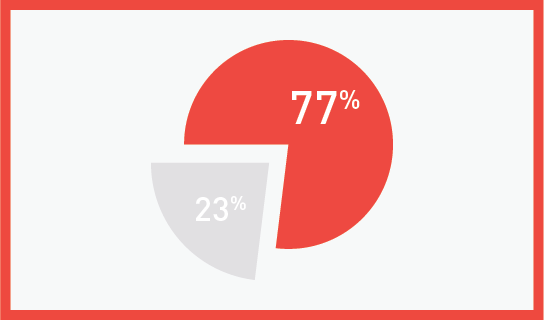
Bizarre, don’t you think? Here’s where the empathy and authenticity hits the jackpot: DNA Info New York notes that the business is “recognizing the difference between the average pay of women and men–77 cents on the dollar, according to the labor department–charging ladies only 77 percent of their bar tabs.”
Even though the idea itself stems from the Lean In D.C. chapter of Sheryl Sandberg’s Lean In movement, I thought it was a great promotional stint. Then it hit me: Is this a one-time marketing idea, or should it turn into a business model?
I spend a lot of time with entrepreneurs defining their brand positioning at the onset of their company foundation, and the lines between sales opportunity, marketing shtick, and authentic brand promise tend to blur quickly. And that is a mighty good thing.
Toms gets rightfully credited for creating the “one-for-one movement,” which acted as the foundation to a tremendously successful business model that has been adopted by countless others, from Warby Parker to Yoobi. It’s a new twist on an old sales tactic: buy one, get one free.
Entire companies are now based on what used to be “special promotions,” and they’ve made it their meaningful brand promise. The huge success of celebrity chef Danny Meyer’s Shake Shack can be attributed to his “enlightened hospitality” mantra, which is taken into action through the burger chain’s staff being overly generous to customers. Yes, you might get a free dessert because a waiter decided you deserved it.
Startups that successfully weave sales tactics into their brand’s positioning are becoming more and more prevalent by making truly meaningful experiences for customers. Looking at the one-day promotion by the Brooklyn bar made me wonder why the 77 percent discount should not turn into the next one-for-one model for other businesses.
Hopefully, one day the wage gap will close for good. If your startup is seriously concerned about gender pay inequality in 2015 and beyond, the markup lost in that missing 23 percent can be made up in many other ways. Attracting a passionate audience that will fully embrace and share your brand–that might be more difficult to accomplish.
Just my 23 cents on a topic that I hope will be taking branding, and the startup scene, by storm–and rightfully so.
Marking New Frontiers
Addressing the Exploration Foundation Summit 2015 at Caltech on the importance branding plays in explorations.
CATEGORIES:
4 Ways to Maximize a Branding Tool You Are Already Using Every Day
An edited version of this article was originally published on Entrepreneur on June 25, 2015.
Rarely given much thought in brand creation or marketing efforts, your email signature can sometimes be seen by hundreds of eyeballs on a daily basis. Once you start thinking of this rather minuscule part of your communications a little more strategically, you will see how it can easily turn into an important branding tool with a build-in and engaged audience — a tool that is personal and, yes, free.
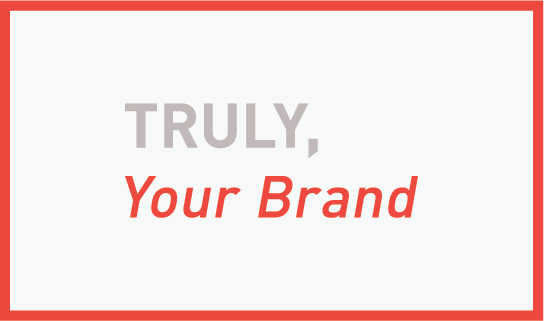
Your signature can further engage current clients and partners or educate potential clients and employees about your brand’s mission and culture. Working with entrepreneurs day in day out, I always stress the signature as the most simple, yet most overlooked brand asset. Usually it is being greeted by a “deer in the headlights” type of aha moment, one that I would love to project upon you by sharing four incredibly easy ways to push your brand upwards, while sending your emails outwards:
1. Resurface or re-purpose your tag line
The tag line used to be one of the key brand communication tools. Things shifted and today tag lines often end up being the headline on your landing page or used in certain lock-ups of your logo only. It’s time to celebrate your tag line again. It is a clever elevator pitch in a few words that quickly describes your brand’s purpose, and the email is the perfect piece in your marketing mix for it to live, be shared and live on happily ever after.
2. Showcase all of your brand’s active social-media channels
This one’s a no-brainer. Now check your signature and make those updates to ensure all social brand channels are indeed showcased as there are new ones popping up faster than you can read this article.
There is no easier way to gain followers that care. Period.
3. Leave them with your genuine thoughts, not a dead man’s quote
People are over the inspirational quotes and they don’t need to know you message was sent using your iPhone, tablet or even smartwatch. Instead, use your signature real estate to highlight the latest blog post you wrote or share interesting news of your brand – another way to create more touch points. Remember that you already have the attention of a reader, and she is only one click away to learn more about your brand. The “leadership area” of your signature as I like to call it, can be individualized by department or receiver, too. This can ensure the information is personal and relevant.
4. The more data used, the more important design becomes
All said and done, ensure your signature is not overwhelming. It needs to always be the second read after your message, even when you reply to an email with solely the two letters “OK.” The signature should always feel just like that: a place to either grab a phone number or address from or to further engage with your brand; the latter you will now have successfully achieved.
To further help you visualize these tips, I am equally reluctant and happy to share with you my E-Mail signature, as it reads of June 22, 2015.
That being said, signed truly,
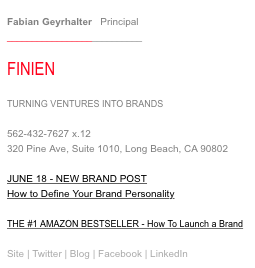
How To Define Your Brand Personality
What is your brand personality? Hint: It’s not your personality. It’s not your team’s vibe. It’s not the look and feel of your product. It might not even be what you had in mind when starting your company.
It’s time to define what your brand’s personality actually is, and I am glad to share ‘the secret sauce’ with you.
A brand’s personality is derived from keywords that best describe your brand’s character as if your brand was a person. You think about how your brand wants to be perceived by your target audience – how it wants to make them feel. Who is your brand as a person? Is (s)he helpful, clever, feisty, glamorous? Below graphic from my bestselling book How to Launch a Brand describes this process and can help you get started on this simple, fun and extremely powerful early branding exercise, which is best done together with your team:
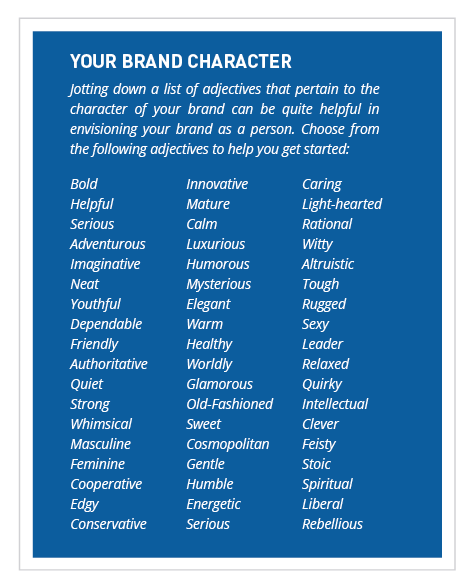
After compiling your list of keywords, associate each keyword with one or more brand personality archetypes. See the archetypes we like using, together with example keywords, below:
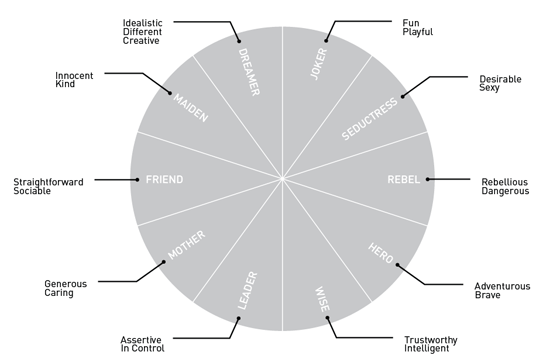
At the end of that exercise, you will see which three personality archetypes have the most keywords associated with them. Those are the personality traits your brand needs to fully represent from here on out in all of its visual and verbal communications. This simple yet very meaningful exercise should assist in defining the company name, the brand identity design as well as the brand atmosphere.
Looking at Target as an example most of us are familiar with, it quickly becomes obvious that we see Target first and foremost as a Friend, a Mother, and a Dreamer. What is your brand’s personality? Get your team together in a room, put your therapist hat on and find out!
Going through a brand transformation? Contact us to discuss how we can enable your relaunch.
Launch Glocally – Not A Choice, But A Necessity
It is a fact, we have all gone completely glocal!
To think about cultural diversity means inclusivity, not exclusivity. It speaks to today’s Zeitgeist. You think globally, but you act locally – it’s how we live our lives today and it’s how we launch brands today, which leads me to your very own brand launch.
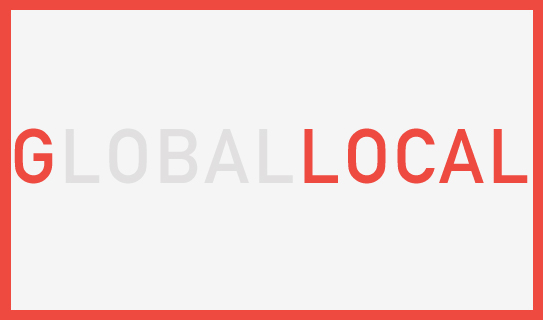
Your new brand will be exposed to a global audience from the get go even if you set out to create a very local or regional brand. Plan your brand launch around a very specific and narrow audience (you need that focus), but craft your brand name and design to have a unified global appeal in order to be embraced in other markets. Your positioning and core values should work globally, but a local strategy is where you touch communities.
Thinking global mitigates the risk of depending on one country or region’s economy for your success – you can easier move towards new markets if you think globally from the start. As a startup you don’t want to alienate future markets. Even if you intend to create a local-only brand, cultures within most regions are diverse, so by thinking global, you will ensure in a worst case not to offend, and in a best case to attract a larger, more diverse audience. Additional glocal incentive, if you needed it: Investors want to see global thinking and ambition and will likely make larger investments in your venture.
So how do you get there? Keep these 4 rules in mind as you develop your brand:
1. Craft and test
Carefully craft and test your brand name, brand identity design and brand voice to make sure it is globally accessible and acceptable
2. Position universally
Find universal values or truths that you can leverage with your brand positioning
3. Think 10 years
Think about how you want to have impacted mankind with your brand a decade from now. It will make you launch as a global brand, nearly guaranteed
4. Hire diversity
Employ staff with international experience and a global view, making you an authentic glocal venture from within
With these in mind, you should be in the right state to go completely glocal! You won’t regret it.
—
Marissa Hui, a key influencer of FINIEN’s naming and design strategies for our clients over the past years, is a contributor to this post. As Marissa is moving up North (onwards and upwards as they say), I want to take this opportunity to thank her for all her hard work, also on behalf of those readers who had a chance of working with her. Farewell Marissa!
CATEGORIES: Blog Your Brand Launch: Brand Strategy
5 Ways To Create A Timeless Brand
Creator, the beautiful online magazine of wework, the highly inspirational community of creators, published an original article by yours truly yesterday, so I thought sharing is caring. It goes something like this:
If I say “Coca-Cola,” you probably see the cursive typeface, red and white colors, curved bottles, and polar bears, right? That’s because Coca-Cola has spent decades building its brand with precise imagery, a consistent logo, and steadfast messaging.
While Coca-Cola is the quintessential timeless brand, many entrepreneurs have a tough time replicating its success because they’re drawn to the latest fads. Unfortunately, that’s not the key ingredient for enduring the test of time.
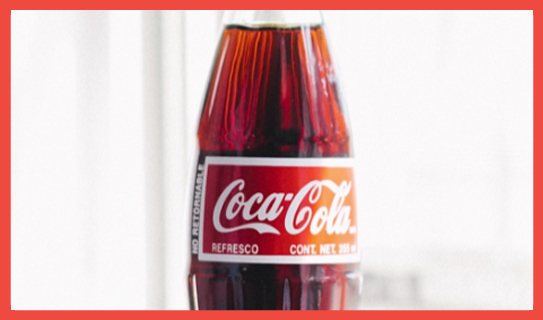
Photo credit: Lauren Kallen (Via Creator)
Styles change, but your company’s name and logo should not. You need to get it right from the beginning so you won’t confuse your target audience. It’s imperative that you create a brand that reflects your company’s values and is based on a shared passion with your target audience.
The brand that stays top of mind with consumers is the one that was built with “soul,” is driven by passion, and is marketed truthfully and consistently. A brand like Coca-Cola is truly timeless. Despite shifting marketing and advertising efforts, the brand is always surrounded by its unmistakable logotype and color scheme.
So how do you build a timeless brand? Here are five tips to get started:
- Buck the trends. If it’s in the moment, it’s unlikely to be in the future. Trends don’t hold up over time. People want something that stands out. A trend is cool for a very short time, then it quickly turns into an annoyance. The more honest and creative you are when crafting your brand identity, the more likely it is that you’ll create something timeless.
- Find a unique angle. If you try too hard to be like everyone else, you won’t be able to define your own unique brand identity. Look beyond your competitors, and dive deep into your own beliefs. Nail down what you’re about as a company, basing it on your core values, then determine how you want to communicate that to your target audience. Once you decide exactly what message you want to get across to your audience, you can create a truly unique visual and verbal brand language that’s lasting.
- Define your brand. A timeless brand has a shared passion with its audience. For example, Patagonia makes clothing for people who love climbing, skiing, and other outdoor sports that don’t require a motor. The brand caters to anyone who likes to connect with nature—hence it was able to expand from climbing gear to items for all other outdoor activities without losing its focus. This shared passion is directly reflected in the company’s sales because saving Mother Nature equals saving its audience’s playground.
- Be consistent. Your company name and logo are the first things that people will think about when your brand comes to mind, so keep them consistent. Make sure your logo is distinct, easy to adapt across different media types, and reflective of what your product or service actually delivers. (Hint: As you can learn from Zappos, it’s happiness, not shoes.)
- Avoid being too descriptive. When launching your brand, stay away from a name or logo design that’s too descriptive to avoid costly rebranding as your core focus shifts in the future. The uncertainty surrounding a rebranding effort could cost you time, money, and even loyal customers. At the very least, you’ll confuse them—as we recently saw with Airbnb’s rebrand PR nightmare.
When you solidify your brand from the start, you can focus on stabilizing it and investing in it. A brand that’s in unison with its identity remains relevant over time, and every party involved knows why the brand looks, walks, and talks a certain way. Base your brand on your unique offering, and connect with your audience meaningfully—you’ll be well on your way to developing a timeless brand.
Is Your Startup Turning Into The Meh Factory?
You start off with a grand vision, the big thought. You can imagine the person who will go crazy over your offering right in front of your eyes.
As you find yourself diving head-first into product development, in many cases your target audience starts to automatically widen and with that you run the risk of your startup turning into a factory of…meh.
A Meh Factory is pointing towards, and hitting the center of the bullseye perfectly. A good thing you’d assume, but the bullseye is smack in the middle of everything: not too this, not too that, it’s just right in the middle. A product that tries to appeal to everyone and do everything. It is not the cheapest, not the priciest, not the coolest, not the best – no, it’s just right there, sitting stagnant in the middle of it all and by hitting the target spot-on, it is missing its target audience, its initial reason for existence, entirely.
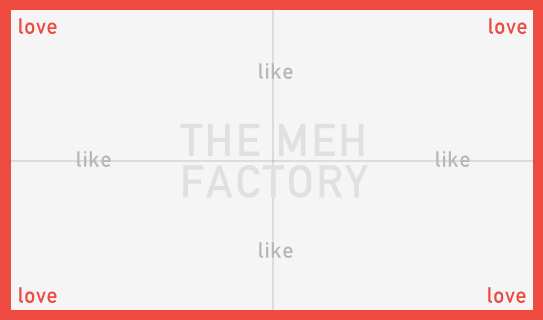
Becoming a Meh Factory is an even easier trap to fall into for an existing brand that is losing its soul, a great example being Gap (You can indulge in this story, exemplifying a brand’s quest to remain relevant).
As a startup you can protect yourself from falling into this gap (sorry!) early on. As you enter the development phase, remind yourself that as a new brand on the market it has to be your main goal to work towards reaching someone’s heart and not everyone’s mind. Only if you get one ‘tribe’ to not only like, but fully love your offering can you create a cult brand. And that is exactly what you should target. Shoot into any corner, just don’t point towards the center as you’d be missing your target – you know, the person you were thinking of when your idea first popped into your head. Make her love your brand, others will follow.
Twitter’s Periscope: What’s The Naming Scope
As you may have heard, Meerkat now has a new, serious, competitor. And no, it’s not the Minneapolis agency Periscope, which greatly enjoyed getting a lot of buzz today when Twitter launched Periscope.
Twitter did not talk to the agency by the same name, has not asked them for their Twitter handle @periscope (Wait, really? They kept @periscopeco), nor cared about the fact that they are naming their product the same way. Twitter decided to stick with the name of the startup they acquired, a very ‘speed-to-market’ move, and when it comes to naming, a highly questionable one.
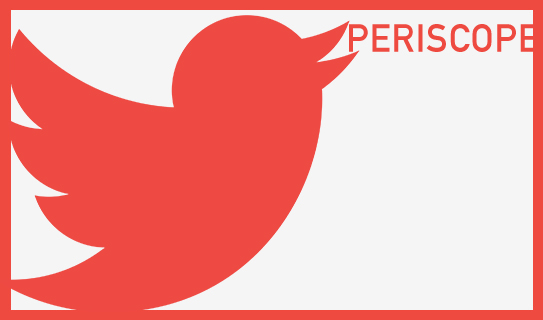
Twitter is 36.5 million followers larger than the agency by the same name, and the world will, after just a few days, think of Twitter’s service – and Twitter’s service alone – when hearing the name Periscope. Periscope, the agency, will not be so happy about it when confusion turns into annoyance and a dillusion of their smart brand name.
The question remains: Why stick with the name Periscope? A rather great name for a ‘full-spectrum creative agency’ that helps uncover and look at things differently, but for a live-streaming app?
Given all the red flags, they kept going with a name that stands for an apparatus consisting of a tube attached to a set of mirrors or prisms, by which an observer (typically in a submerged submarine or behind a high obstacle) can see things that are otherwise out of sight (via Google).
Leaving early adopters to adjust to a new name in order for a brand to focus on its much bigger future after having serious funding infused, or being bought by the big guys, would be the right move. Startup names are often just that, they are quick MVP’s of something that really should not be driven by lean startup methodology to start with. And definitely not go past an acquisition or merger.
CATEGORIES: Startup Advice Your Brand Launch: Naming
Your Brand’s Core Values: From Document To Embodiment
Deriving your venture’s core values early on is essential to formulating a strong brand from within.
Imagine your core values being displayed beautifully in your company’s lobby: Your team will see them every day and it should engage and inspire them. At the same time, clients and shareholders should be able to read, and be in agreement with, your core values actually representing, and serving, your brand well. They need to resonate across the board. We advise to keep those value-statements to three very short and actionable sentences (some of the more universally applicable examples we derived with our clients in the past months are shown below):
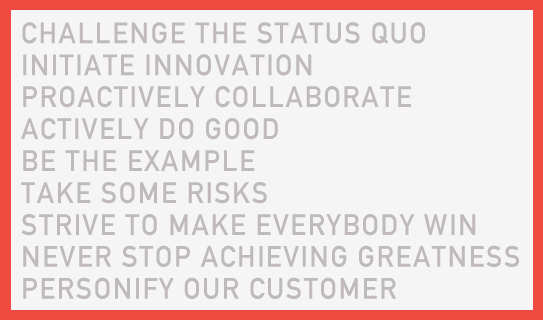
It is easy to notice that core values often sound similar, perhaps even a bit generic if taken out of context, regardless of how hard we worked with our clients on crafting them. They often do not feel naturally implementable either. No surprise then that they often stay put on a desktop in a PDF document, rather than being embodied by the team.
I gave this issue a lot of thought as I urge my team and myself to create work that is intrinsically being embodied by our clients to push their ventures into great brands.
I recommend embodying your core values the same way I would recommend you preparing for a very important presentation: Once you have the presentation deck done, the speaker notes inserted, and you start practicing, you will realize that the more you practice, the more you embody the content and overall spirit. The day of the presentation you will notice that you fully embody the content, to the extent that you could hold a successful speech even if a major electricity outage hit – in candle light, without slides, without speaker notes – because you are living the content.
Treat your core values the same way: Try assigning one of your new brand’s three core values to each day of the work week, then make it your goal to do something each day that turns the words of one core value into action. It might be a project scope document and you decide to question the status quo and try to turn it into a better product. It might be actively doing good and being the example by staying late to help a co-worker meet her deadline.
Examples are endless, core values there are only a few, so if you start checking one value off the list day after day over the course of two weeks, and you ask your team to be doing the same, you will quickly realize that you do not have to be reminded about the values anymore – you will just be doing it. This will be the magic moment where you will be embodying your brand’s core values, and that brand document that resides on your desktop can now be accidentally erased, because it does not matter anymore. Action, as we all know, speaks louder than words.



